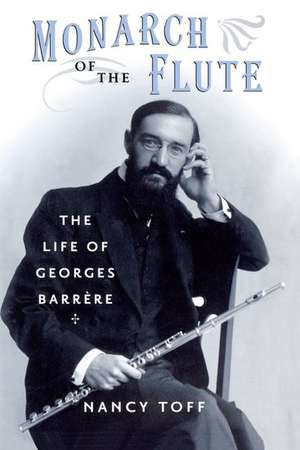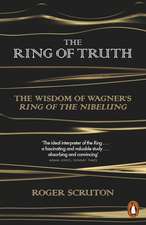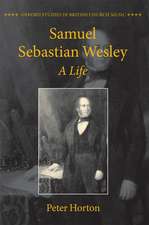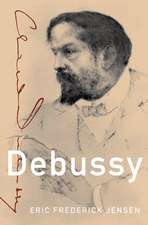Monarch of the Flute: The Life of Georges Barr`ere
Autor Nancy Toffen Limba Engleză Paperback – 27 sep 2012
| Toate formatele și edițiile | Preț | Express |
|---|---|---|
| Paperback (1) | 348.60 lei 31-37 zile | |
| Oxford University Press – 27 sep 2012 | 348.60 lei 31-37 zile | |
| Hardback (1) | 497.08 lei 31-37 zile | |
| Oxford University Press – sep 2005 | 497.08 lei 31-37 zile |
Preț: 348.60 lei
Nou
Puncte Express: 523
Preț estimativ în valută:
66.71€ • 69.79$ • 55.41£
66.71€ • 69.79$ • 55.41£
Carte tipărită la comandă
Livrare economică 22-28 martie
Preluare comenzi: 021 569.72.76
Specificații
ISBN-13: 9780199942459
ISBN-10: 0199942455
Pagini: 464
Ilustrații: 26 illus.
Dimensiuni: 155 x 231 x 25 mm
Greutate: 0.66 kg
Editura: Oxford University Press
Colecția OUP USA
Locul publicării:New York, United States
ISBN-10: 0199942455
Pagini: 464
Ilustrații: 26 illus.
Dimensiuni: 155 x 231 x 25 mm
Greutate: 0.66 kg
Editura: Oxford University Press
Colecția OUP USA
Locul publicării:New York, United States
Recenzii
An impressively detailed biography.... The thoroughness that Toff exhibited as she investigated so many diverse sources of information, and her scrupulous attention to detail and accuracy, have paid off handsomely. She writes in a very engaging style, each page replete with fascinating material, and we are forever indebted to her for this landmark biography of our 'great-grandfather' of American-style flute playing.
Once again, Nancy Toff puts her thorough research and journalistic skills to use and creates this fascinating, well-documented look into the founding father of American flute playing. There is no doubt that this book will be part of the standard body of flute literature, just as Toff's other valuable writing, The Flute Book has become.
This is the first work of depth and stature on Georges Barrere (1876-1944), one of the most important flutists in modern history. Barrere, for example, premiered in Debussy's Prelude a l'apres-midi d'un faune (at age seventeen, no less!); and the Griffes Poem and Verese's Density 21.5 were composed for him. Toff has pursued solid credible research including repeated trips to Paris to examine primary documents (Somebody's got to do it," she quipped with a smile at a presentation last summer at the NFA Convention), and the result is absolutely fabulous.
In this detailed view of Barrere's life, Nancy Toff weaves an amazing musical tale of two cities, Belle Epoque Paris and early 20th-century New York...This book is a good read. Clearly and logically organised, with really useful appendices and index, it shows how the man and his music developed. Fascinating and informative, I found it hard to put down. Fascinating because it reveals how a playing musician lived and worked (so often we only hear about how composers lived), and informative because by the end of it, I felt as though I too had lived through that time.
The breadth of Nancy Toff's scholarship is evidenced in her vivid, detailed depictions of the two milieus in which Barrere played very influential roles: fin de siecle Paris and American musical life between 1905 and 1944, particularly in New York City. Through painstaking research in Europe and the United States, she has performed an immense service for the international woodwind community, rediscovering and placing in musical and historical contexts unjustly neglected but worthy solo and chamber repertoire written for Barrere. The wealth of information provided makes this book a resource of immeasurable value for all woodwind players.
Once again, Nancy Toff puts her thorough research and journalistic skills to use and creates this fascinating, well-documented look into the founding father of American flute playing. There is no doubt that this book will be part of the standard body of flute literature, just as Toff's other valuable writing, The Flute Book has become.
This is the first work of depth and stature on Georges Barrere (1876-1944), one of the most important flutists in modern history. Barrere, for example, premiered in Debussy's Prelude a l'apres-midi d'un faune (at age seventeen, no less!); and the Griffes Poem and Verese's Density 21.5 were composed for him. Toff has pursued solid credible research including repeated trips to Paris to examine primary documents (Somebody's got to do it," she quipped with a smile at a presentation last summer at the NFA Convention), and the result is absolutely fabulous.
In this detailed view of Barrere's life, Nancy Toff weaves an amazing musical tale of two cities, Belle Epoque Paris and early 20th-century New York...This book is a good read. Clearly and logically organised, with really useful appendices and index, it shows how the man and his music developed. Fascinating and informative, I found it hard to put down. Fascinating because it reveals how a playing musician lived and worked (so often we only hear about how composers lived), and informative because by the end of it, I felt as though I too had lived through that time.
The breadth of Nancy Toff's scholarship is evidenced in her vivid, detailed depictions of the two milieus in which Barrere played very influential roles: fin de siecle Paris and American musical life between 1905 and 1944, particularly in New York City. Through painstaking research in Europe and the United States, she has performed an immense service for the international woodwind community, rediscovering and placing in musical and historical contexts unjustly neglected but worthy solo and chamber repertoire written for Barrere. The wealth of information provided makes this book a resource of immeasurable value for all woodwind players.
Notă biografică
Nancy Toff is author of The Flute Book, The Development of the Modern Flute, and Georges Barrère and the Flute in America and is a past president of the New York Flute Club. Toff is the 2012 winner of the National Flute Association's National Service Award.













